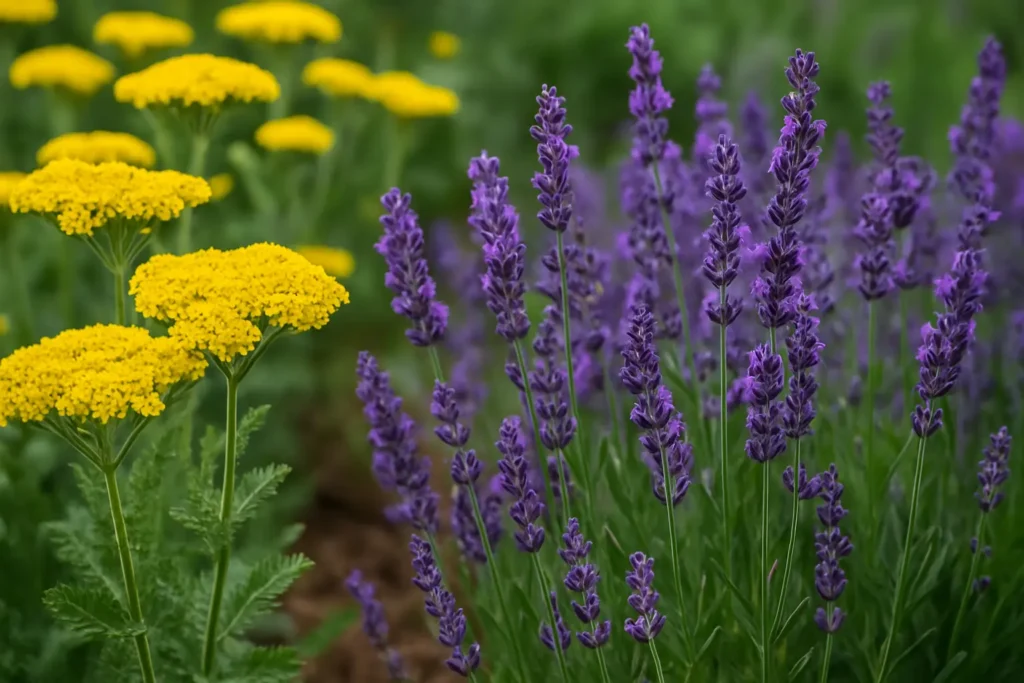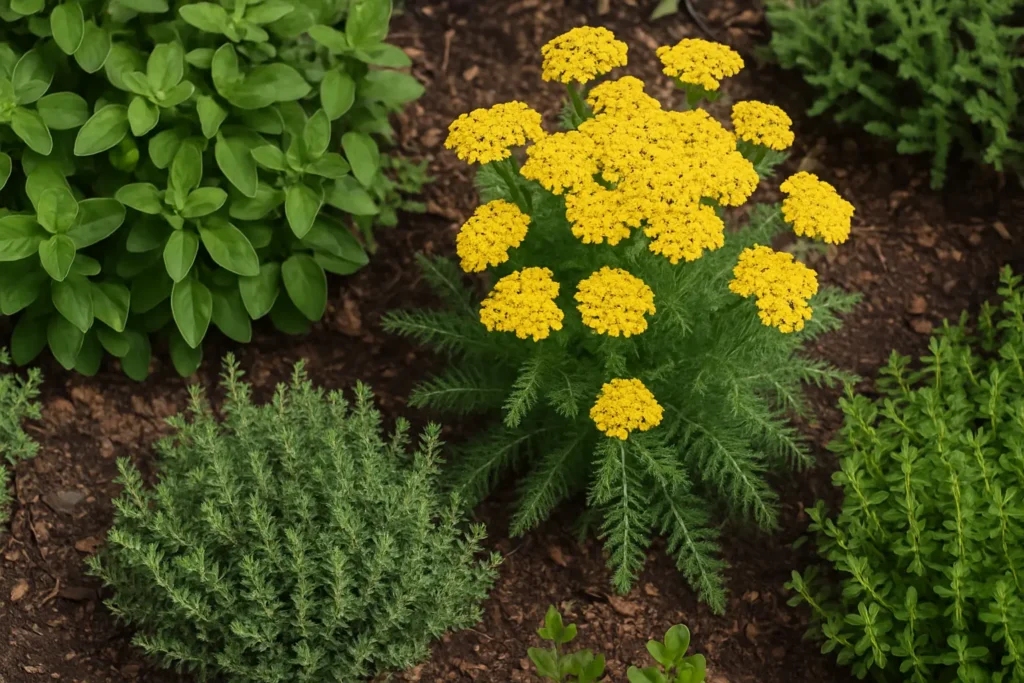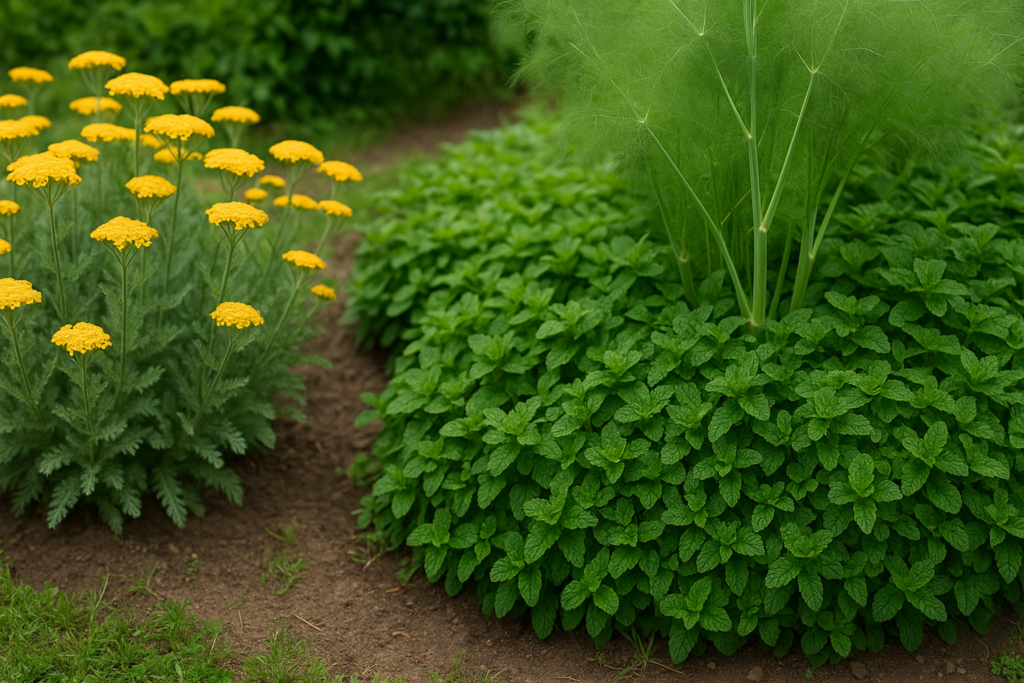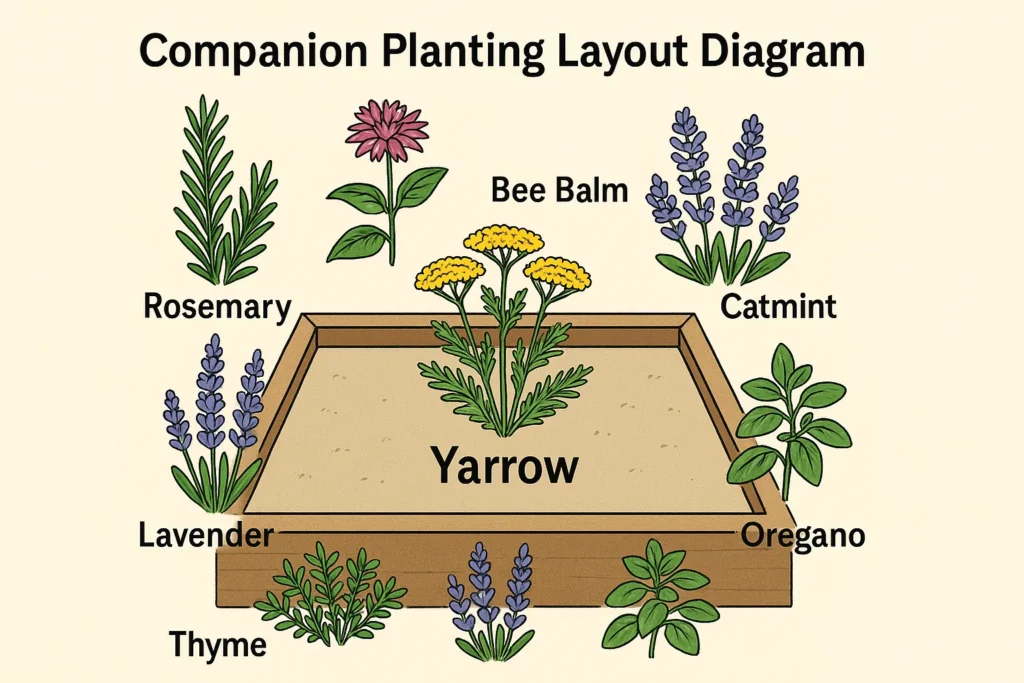Yarrow Companion Plants: What to Grow (and Avoid) With Yarrow

Yarrow is one of those garden staples that quietly outperforms its appearance. With its feathery foliage and clusters of tiny flowers, it may not always be the showstopper—but what it brings to a garden makes it an invaluable partner. Gardeners love it for its hardiness, pest-repelling traits, and ability to attract beneficial insects. But as with any companion planting strategy, success depends heavily on what you plant alongside it.
Whether you’re planning a pollinator bed, a herb patch, or a wildflower corner, knowing the best yarrow companion plants—and those to avoid—can make all the difference.
Table of Contents
Why Yarrow Companion Plants Matters?
Yarrow (Achillea millefolium) is often celebrated for its low-maintenance needs and drought tolerance. It’s a natural multitasker in the garden: attracting pollinators, improving soil quality, and even enhancing the aromatic oils of neighboring herbs. But its assertive nature—spreading by both rhizomes and seeds—means it doesn’t always play nicely with others.
Some gardeners swear by planting yarrow in the center of their beds, letting it anchor the space visually and ecologically. Others argue it can get too aggressive, crowding out more delicate species. Like many things in gardening, the truth depends on your soil, sun, and how closely you watch your plants.
For additional information on caring for yarrow and understanding its full potential in a mixed garden, refer to these Achillea (Yarrow) plant care tips from the RHS.
Best Yarrow Companion Plants
Shares sun and soil needs with yarrow; both deter pests and look stunning together.
Great drought-tolerant combo; attracts pollinators like bees and butterflies.
Creates a bold pollinator garden; does best in slightly richer soil than yarrow.
Low-maintenance companion that blooms alongside yarrow with minimal care.
Perfect for herb gardens; all three thrive in dry, sunny conditions like yarrow.
Reliable perennial that shares blooming season and soil preference with yarrow.
Repels aphids and other pests; works well with yarrow in pest-control beds.
Acts as a trap crop; vibrant blooms add color contrast and protect nearby plants.
Can be invasive and compete with yarrow for space and nutrients—plant in containers.
Some gardeners report enhanced pollination; others face pest issues—results vary.
Need more water than yarrow; differences in watering needs may cause stress.
Competes for nutrients and may inhibit growth of nearby plants like yarrow.
Heavy feeders and pest-prone; not ideal near yarrow in most garden setups.
Pollinator Magnets That Pair Beautifully
Lavender is a classic companion for yarrow. Both prefer full sun and well-drained soil, and the color contrast between lavender’s purple spires and yarrow’s yellow or white flowers can be striking. Some gardeners find that lavender can be a bit picky in humid climates though, while yarrow thrives regardless—so it’s not always a perfect match.
Coneflowers (Echinacea) grow with a similar upright habit and thrive in the same tough conditions. Together, they form a resilient, pollinator-friendly duo. A few gardeners note that yarrow can outcompete younger coneflowers, but spacing them properly tends to resolve this issue.
Bee Balm (Monarda) offers a bold, shaggy bloom that contrasts beautifully with yarrow’s tighter flower heads. Both attract bees, butterflies, and hummingbirds. That said, bee balm prefers slightly richer soil, so in leaner conditions yarrow may dominate.
Catmint (Nepeta) blends well with yarrow, forming a soft, layered look that blooms for months. Both plants are drought-tolerant and resist deer and rabbits. Some gardeners mention catmint can reseed vigorously, but it’s rarely considered a problem when combined with yarrow.
Herbs That Thrive with Yarrow
Yarrow makes a surprisingly good partner for certain culinary herbs, especially those that prefer sunny, dry conditions. Think rosemary, thyme, and oregano. These Mediterranean natives thrive in similar soil and are not shy about standing their ground. Interestingly, yarrow is also said to enhance the essential oil production in nearby herbs—though hard data is thin, many home gardeners stand by this claim.
If you’re planting in raised beds or containers, use the Plant Spacing Calculator to ensure adequate airflow between dense herbs and yarrow.
Pest-Fighters That Protect
Marigolds may not seem like an obvious match for yarrow, but their pest-repelling reputation makes them a practical addition. Aphids, in particular, avoid marigold-heavy plots—and yarrow does its part by luring beneficial predators like ladybugs. Some argue marigolds look a bit out of place in a more naturalistic garden bed, but that’s a design preference more than a plant compatibility issue.
Salvia, another drought-tolerant perennial, pairs nicely with yarrow. Both bloom through summer and require little fuss once established. The only caution? In very dry climates, salvia can sulk if soil gets too lean, while yarrow marches on.
Bonus: Unexpected but Effective Companions
A few surprising options have worked for many gardeners, even if they’re not the usual recommendations:
- Nasturtium adds a splash of color and serves as a trap crop for aphids.
- Echinops (Globe Thistle) may seem too spiky or aggressive, but it complements yarrow’s fine texture beautifully.
- Black-eyed Susans (Rudbeckia) are sometimes avoided due to overlapping bloom times, but they create a golden field effect when timed right.
What Not to Plant with Yarrow (and Why)
Nutrient Hogs
Fennel and potatoes are best kept far from yarrow. Both are heavy feeders and can compete aggressively for nutrients. Fennel, in particular, is known to inhibit the growth of many nearby plants—including yarrow, depending on soil composition.
There’s also the matter of pest-sharing. Yarrow attracts beneficial insects, but those same insects can sometimes be drawn toward your potatoes if they’re too close. If you’re planning a mixed bed, use the NPK Fertilizer Calculator to ensure you’re not underfeeding nutrient-demanding crops like these.
Bullies in the Garden
Mints, especially spearmint and peppermint, can become invasive and overwhelm yarrow. While they technically enjoy similar soil and sun, their spreading habit is far more aggressive. In small beds, one plant usually wins—and it’s not always yarrow.
Similarly, cucurbits like cucumbers and squash may clash with yarrow due to differing water needs. Yarrow tolerates drought; cucurbits do not. Some gardeners have had success growing them on opposite ends of the bed, but it’s a balancing act.
Pests and Disease Companions
There’s debate about whether yarrow and tomatoes should be planted together. Some swear by the combination, claiming improved pollination. Others have seen more pest pressure, particularly whiteflies, when the two are in close proximity. It may depend on your climate or how you manage airflow.
If you’re unsure, try using the Raised Bed Calculator to design isolated zones and test combinations before scaling up.
How to Layout a Companion Planting Bed with Yarrow?
Start by placing yarrow at the center or back of your bed, depending on height. Let it anchor the visual structure. Place bee balm or coneflowers nearby for vertical balance, and fill edges with lower herbs like thyme or oregano. Space generously—especially if you’re pairing with plants that don’t compete well.
Not sure how much soil or compost you’ll need? Use the Soil Calculator before you start hauling bags.
If you’re working with a small area, or trying to squeeze yarrow in among other perennials, the Plant Spacing Calculator is helpful for mapping out optimal placement without overcrowding.
Yarrow Companion Plant FAQs
Can I plant yarrow next to tomatoes?
It depends. Some gardeners report enhanced pollination; others struggle with pest pressure. If you try it, monitor closely.
Will yarrow take over my herb bed?
In rich soil, possibly. Keep it in check with root barriers or give it its own section.
Is yarrow good for pollinators?
Absolutely. Bees, hoverflies, butterflies—it’s a pollinator magnet.
Does yarrow improve soil health?
There’s anecdotal evidence it helps accumulate potassium and phosphorus, especially in tired soils. Scientific consensus is mixed, but the belief persists.
Final Tips for Growing Yarrow with Friends
Yarrow is an incredible companion plant—but like all companions, it thrives in the right relationships. Choose its neighbors wisely, and you’ll not only enjoy a healthy, thriving garden, but also reduce your workload across the growing season.
Before you start digging, take a few minutes to check spacing, bed size, and soil volume using our planting calculators. A little planning can go a long way toward a harmonious garden.
Yarrow may be easy to grow, but growing it well—with the right companions—is a skill worth mastering.




